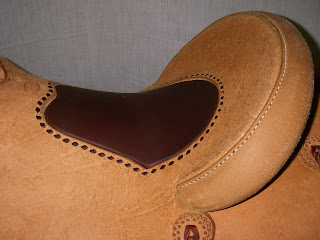Here is a series of photos that will help explain the process of stamping leather, I am making a pair of wrist cuffs.
The tools used for this project are:
-small stamping maul made by Don King
-med stamping maul made by Barry King
-wing dividers made by C.S. Osborne(very old)
-San Carlos border stamp by craftool
-geometric stamp by Don King
-Beveler made by me out of a bolt
-seeder by craftool
-two border stamps by Don King
-double cut border swivel knife(or beader blade) by craftool
-bag full of lead shot used as a weight

The leather needs moisture to take the impression of the stamp, but there is more to it than that. If you simply wet the leather then immediately stamp it, the leather will take the impression of the stamp, but the impression will have no color and will not be a very clean crisp impression. To get the best out of your stamp the leather must be "cased". To do this the leather is wet, then dried back some and placed in a bag, an airtight container, or between some wool blankets. You leave the leather for a day or two until the moisture content is even throughout the leather. Then your leather is "cased", once cased the leather is not wet nor dry, it is damp throughout. Now your stamp will leave a very clean and crisp impression on the leather, and if and only if your leather is "cased" properly the stamping tool will not only leave a crisp impression in the leather but the tool will also burnish the leather giving you much more depth and color to your stamping.
Once the leather is cased the double line borders are layed out and cut into the leather.

Then the first row of San Carlos border is stamped

Then the second row of the San Carlos Border.

Now the geometric stamp is layed out and stamped into the leather, each impression is meticulously placed.

Continue stamping until you filled in the whole piece.

Then the outsides of the double line border are beveled, the seeder is used in all corners, next the smaller outside border is stamped.

Then the inside border is stamped.

Now that the stamping is done, the leather allowed to dry completely at room temp. Once dried it is edged, oiled, the finish is applied and assembled.
Once I have finished all these steps I will post a photo of the wrist cuffs when they are complete.
In the near future I will also show the process of flower carving.





